5 things you’ll love (and 2 you might not) about the Kimpton Shinjuku Tokyo
Kimpton hotels are known for their alluring social spaces, out-of-the-box experiences like nightly wine hours, their pet-friendly policies and clever marketing strategies, such as complimentary perks for guests who know the secret seasonal password.
As the brand’s long-awaited first location in Japan, the 151-room Kimpton Shinjuku Tokyo debuted in 2020, promising to be a stylish, youthful hotel, replete with Instagrammable interiors and cosmopolitan vibes. Designed by the eminent New York-based Rockwell Group (who also decked out the New York Edition and Nobu Miami Beach among many other projects), Kimpton Shinjuku Tokyo emulates the contemporary style and creative energy of New York City rather than Tokyo’s futuristic dynamism, which may seem quite odd to Kimpton devotees accustomed to bedding down in hotels rooted in the surrounding neighborhood.
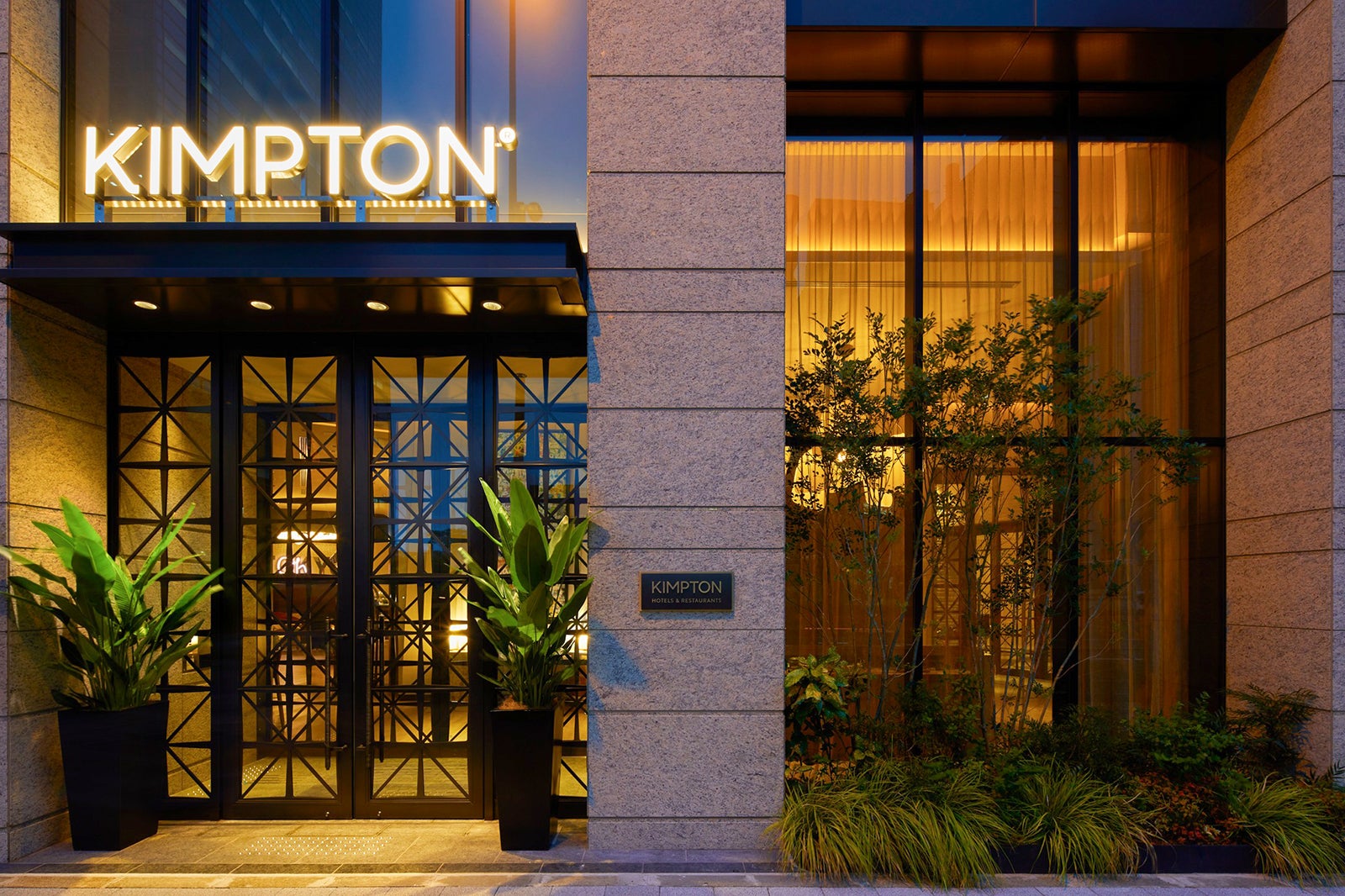
The hotel became a favorite with domestic travelers (and their pets) during Japan’s pandemic-related border closures. But as international travelers have flocked to the country since it reopened and hotel rates have soared over $1,000 a night at many upscale hotels in the capital, the Kimpton Shinjuku Tokyo has also quickly become a popular option for guests looking to stay at a stylish hotel, without having to pay sky-high prices.
That said, the Kimpton Shinjuku Tokyo won’t appeal to everyone. Some of the rooms are cramped and noisy and there aren’t many family-friendly amenities. Still, at this price point and with generally good points availability, the hotel is a great option for many travelers.
Here’s everything you need to know before booking a stay at the Kimpton Shinjuku Tokyo.
Snapshot
Housed in 17-story art deco-style building, the Kimpton Shinjuku is a 10-minute walk from the epicenter of its namesake district, known for its neon-lit skyscrapers, izakaya (bar)-studded alleyways and anything-goes entertainment.
Set at the intersection of two busy thoroughfares, it’s just around the corner from the iconic Park Hyatt Tokyo, and a 20-minute walk from popular attractions like the Yoyogi Garden and Meiji Shrine. The famous Shibuya Scramble Crossing and Harajuku fashion district are around a 15-minute taxi ride (or 40-minute walk) away.
Richly textured rooms and spaces exude the creative flair and playful sophistication that Kimpton’s newer hotels tend to embody.
The hotel also nurtures homegrown talent, with dapper bell staff uniformed by a graduate from the neighboring Bunka Fashion College and an “impressionism wall” by local artist Kusumi welcoming guests in the small but inviting lobby. The 17th-floor wedding chapel also doubles as an art gallery with rotating works by local artists.
Why you will love the Kimpton Shinjuku Tokyo
This boutique-feeling hotel is everything Kimpton enthusiasts would hope for — filled with inviting social spaces that deliver trademark city views, fun complimentary features (happy hour socials, morning coffee in the lounge, loaner bikes and in-room yoga mats) and genial elements like the “Cocktail to Match Your Mood” menu at the rooftop bar.
The property is also home to an excellent destination restaurant, District Brasserie, where I ate the best breakfast of my eight-day Japan trip, and a moody cocktail bar that provides an excellent bookend to an evening exploring Shinjuku. If you choose well (there are some rooms to avoid), light-filled accommodations are serene, well designed and functional.
Modern rooms with thoughtful amenities and features
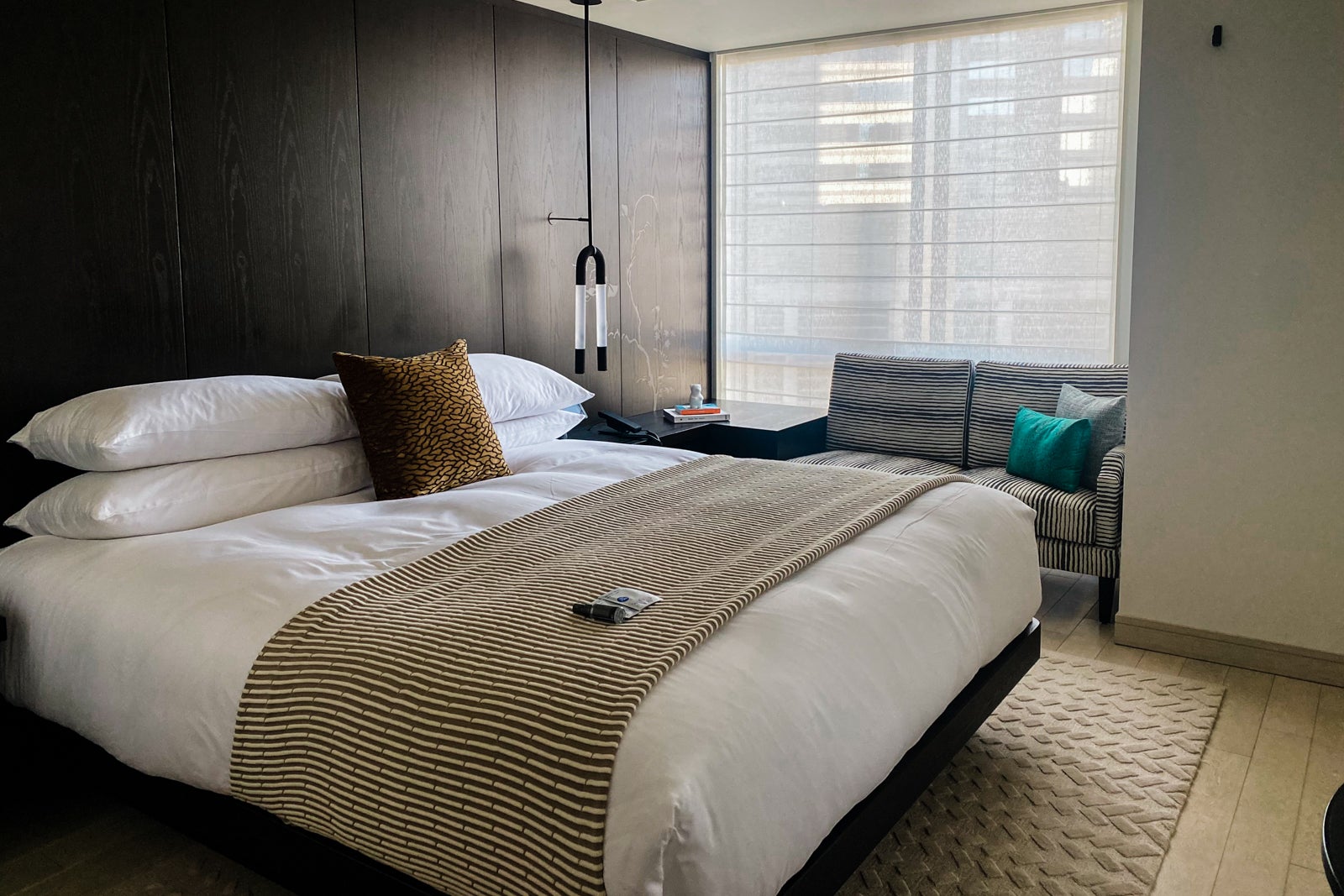
My spry King Premium room (one category up from standard Essential rooms) on the 9th floor measured around 355 square feet and delivered a modern twist on an understated Japanese aesthetic.
Blond wood floors, dark wood-paneled walls, streamlined furnishings and a neutral color palette were all styled with eccentric elements, like beds topped with tiger-print throw cushions, a charming blue-and-white striped sofa with shimmery emerald and silver throw cushions, and a tactile bed runner that added a dose of hygge.
My experience at Kimpton properties tends to be that guest rooms work their magic slowly rather than creating an instant wow factor when you first walk in.
That was certainly the case here with design elements that I didn’t initially notice. There was a Japanese floral inlay that was illuminated when the bedside light was turned on, drawers filled with polished glassware and elegant ceramics to use with the minibar, a spot-on selection of books about Japanese art and Tokyo’s hidden sights by the bedside and a nifty pop-up style closet that housed traditional yukata robes, slippers, a fan and a yoga mat.
The bathroom was where the room tipped into the luxury bracket. Framed in glistening gray marble, the deep-soaking tub and walk-in shower were stocked with refillable citrus-scented products by Atelier Bloom and they were divided from the elegant marble-clad vanity and main bedroom and living area by two screen doors that retracted or slid shut as needed for privacy.
There was a large separate water closet holding a toilet with a heated seat, automatic lid and a flush panel.
Along one wall back in the main room, there was a white console with a smart TV, a Nespresso coffeemaker, a minibar stocked with a selection of soft drinks, wine, beer and snacks, and a large safe. There was a basic round table and two chairs, but unfortunately, they were not positioned close enough to the outlets to make it a functional workspace for long periods. In the entryway, there was a large open closet with plenty of space to store bags and hang outfits.
Tech-forward features included a bedside tablet to access restaurant menus and other hotel information, as well as consoles that controlled the lights and blackout shades.
Destination dining and cocktail bars
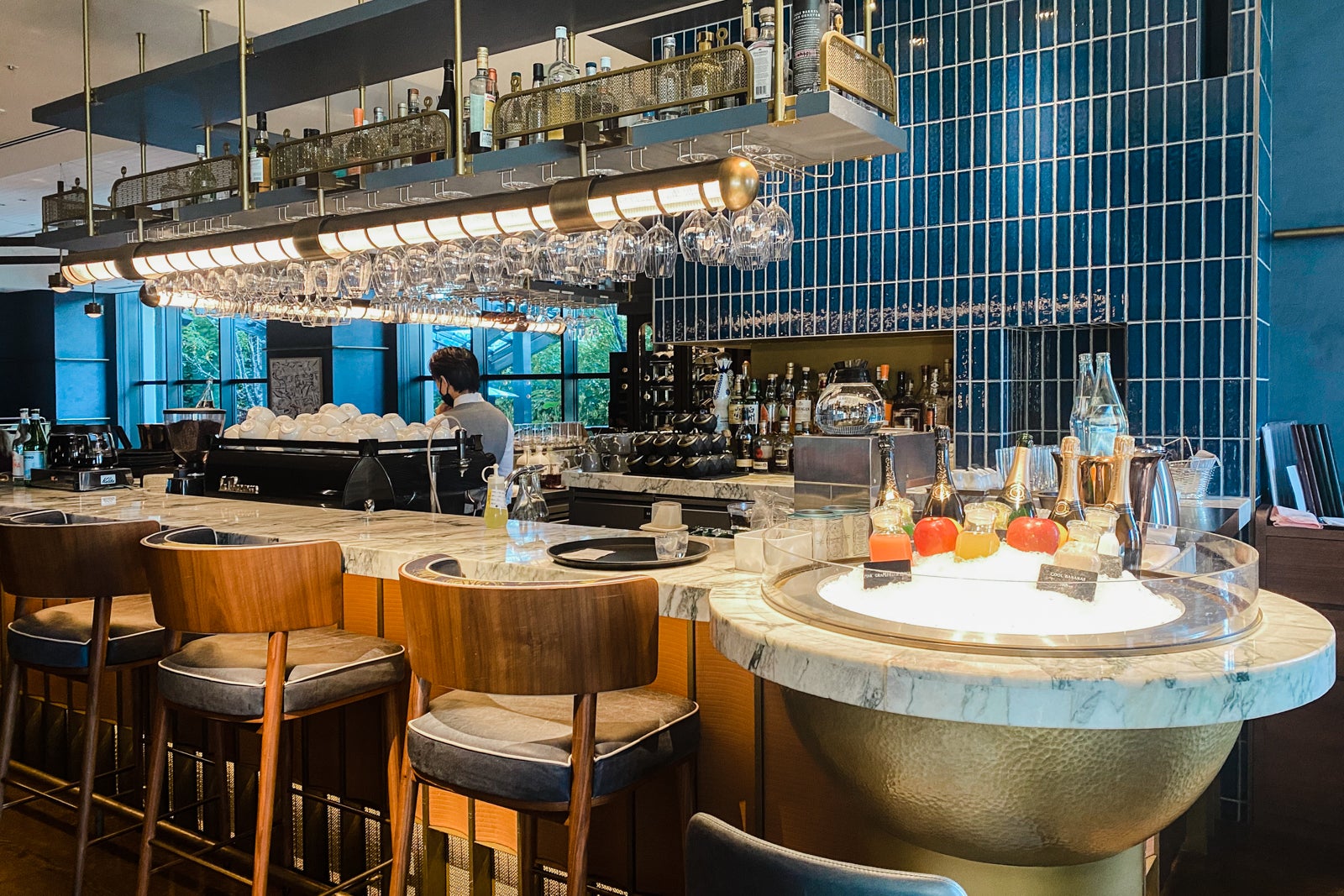
For its small footprint, the Kimpton really shines when it comes to its food and beverage options. On the first floor, just off the lobby, Jones Café and Bar has all the chic, artsy vibes of a New York coffee shop. Behind a marble counter topped with glass cases of delicious baked goods, baristas prepare artisanal coffee concoctions to a soundtrack of ’90s indie music, while locals and guests sink into wall-to-wall brown leather sofas to mingle, read or catch up on work.
On the second floor, breakfast, lunch and dinner are served in the polished District, a brasserie, bar and outdoor terrace, that was packed with locals and tourists during my stay.
To one side, there’s a sunken sitting area anchored by the U-shaped bar where friendly mixologists serve up frisky cocktails, like the Dark ‘n Stormy Meets China (2,200 Japanese yen, or $16) made with rum, spices and ginger.
Steps lead to the main dining room, which combines vintage and industrial elements. Royal blue walls feature brass and copper light fixtures, maroon tufted leather chairs front wooden bistro tables and cozy circular booths give off the clubby vibes you’d expect of an Edition or Nobu hangout.
Sliding doors open onto the leafy outdoor patio area, which was too chilly to draw guests during my November stay, but I can imagine in the warmer months it’s buzzing (despite the noise from nearby street traffic).
IHG One Rewards Diamond Elite guests have the option of complimentary breakfast (or a welcome amenity) when checking in. Otherwise, breakfast costs 5,500 yen ($38) per person, which includes a choice of appetizer and main course as well as bread and pastries and beverages — a la carte options are also available. It’s not cheap, but for the quality, quantity and impeccable service, it’s worth the experience one morning, at least.
Menu options span traditional Japanese fish dishes, wellness-skewed selections like avocado toast, and classic Western plates, such as omelets and brioche French toast, all with an Asian twist. The Japanese fish plate and signature eggs Benedict topped with fish roe were both outstanding.
For lunch, you can expect lighter fare, such as cauliflower rice with seasonal vegetables and sweet chili dressing (2,750 yen, or $19). Evening prix fix menus (from 9000–15,000 yen, or $63–105 depending on the number of courses selected) and a la carte options like fish of the day with seaweed butter crust served with winter melon and saffron broth (4,000 yen, or $28) and Wagyu tenderloin (16,500 yen or $116).
Social spaces and stunning city views
Inviting social spaces are what the Kimpton brand is known and loved for, and this Tokyo outpost is no exception. While it doesn’t have the kind of grand, wide-open lobby that’s common to more luxe properties, it packs a lot of creative energy into a relatively small area.
Next to the minimalist check-in desk, there’s a chic seating section with a few whimsical decorative objects, which seemed designed to create an unpretentious, fun-loving mood rather than being a place you’d actually want to sit and relax. The small concept store also felt more geared toward driving social posts than retail therapy.
The daily happy hour social here also has the bonus of taking place in the swanky 17th-floor lounge where a small terrace affords sweeping views over Shinjuku.
One floor up on the rooftop, the glitzy 86 bar has more sultry, speakeasy vibes — it’s named after the legendary Chumley’s speakeasy at 86 Bedford Street in Manhattan’s West Village — and serves classic cocktails like a Black Sugar Bitter Old Fashioned, made with chocolate bitters and sugar (2,800 yen, or $20). You can also choose from the “Cocktail to Match Your Mood” menu; the I Need a Treat mixes Don Julio tequila, Campari Antica Rosso and cherry (3,800 yen, or $27).
Boutique amenities and perks
With light streaming in from floor-to-ceiling windows and a surfeit of blond wood and mirrors, the gym manages to be inviting despite its compact size. For a city gym in this price category, it’s surprisingly well-equipped with a decent selection of weights, two running machines, a bench, a stationary bike and an elliptical.
In the lobby there are also several bikes that you can borrow to explore the city, which we used to cycle over to the Yoyogi Gardens and Meiji Shrine (a 10-minute ride away) and to explore the Shinjuku National Garden just a few blocks from the hotel. Yogis can also make use of in-room yoga mats (unless staying in an Essential room, because there’s no space to roll it out) and the concept store offers one-off gifts like colorful dog jackets.
Good value, for Tokyo
Hotel prices in Tokyo have skyrocketed since the country reopened post-pandemic, and finding a luxury, central hotel will cost at least $700 per night (and a lot more than that during peak cherry blossom and fall leaf seasons).
At the Kimpton Shinjuku Tokyo, there are 11 room categories to choose from, ranging from capsule-like Essential rooms (more on that later) to one-bedroom suites (738 square feet) with wrap-around windows and gorgeous bathrooms. TPG paid $427 per night for my Essential room. I was upgraded to a King Premium room, which generally runs around $100 more per night.
While the Kimpton doesn’t offer the extensive amenities, grandeur and well-honed service standards of properties like the Four Seasons, Mandarin Oriental and Park Hyatt, its rates are much more palatable than at those palatial redoubts (around half the price), starting at under $400 per night.
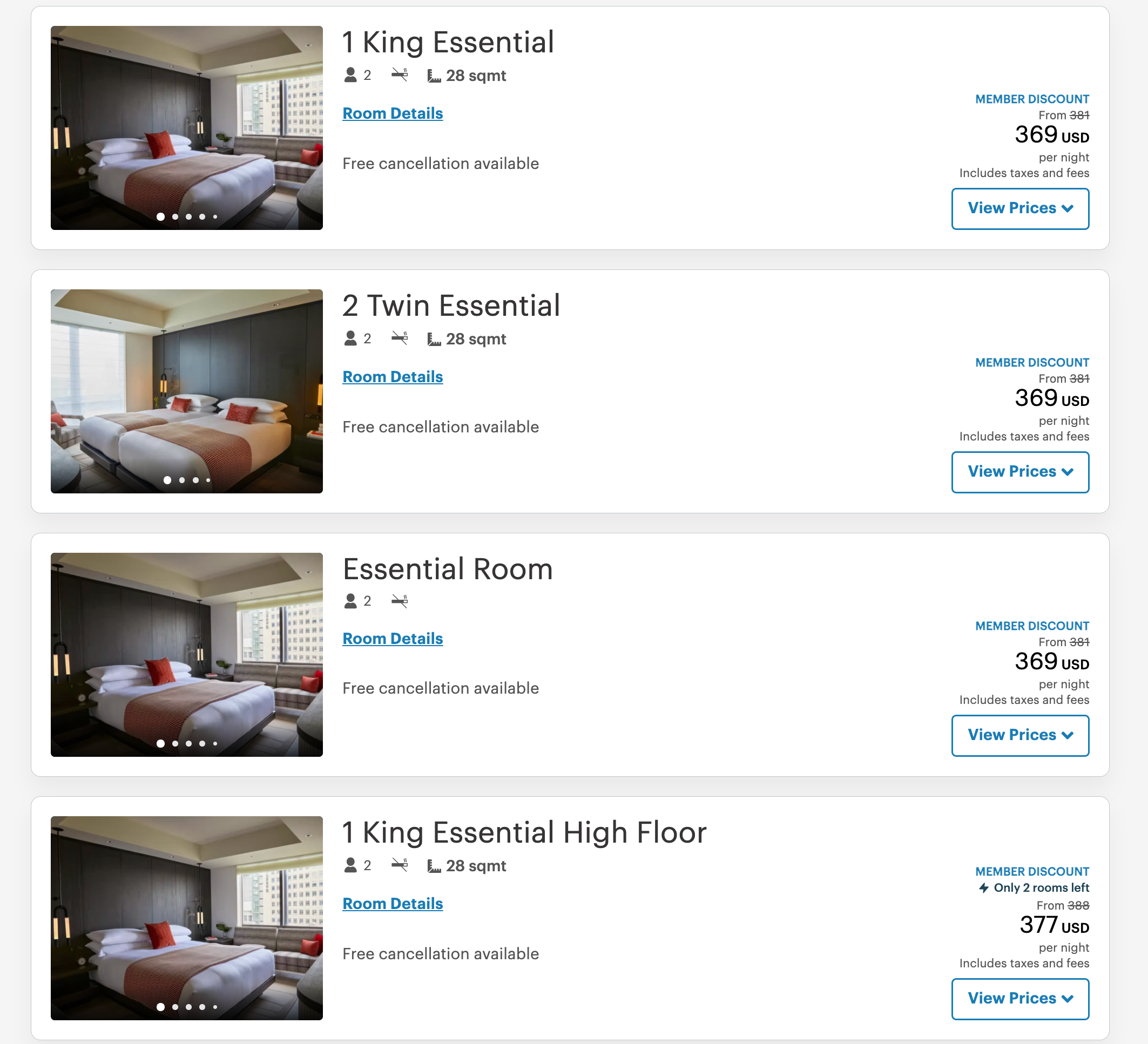
As rates climb during spring and fall, IHG loyalists may prefer to redeem points for award nights that start from 67,000 IHG One Rewards points, over paying cash and accruing bonus points.
Opening a credit card like the IHG One Rewards Premier Credit Card (currently offering 140,000 bonus points after spending $3,000 on purchases in the first three months) would equate to a free two-night stay at the Kimpton Shinjuku Tokyo in that case.
Related: The 11 best hotels in Tokyo for your next Japan getaway
Why you might not love the Kimpton Shinjuku Tokyo
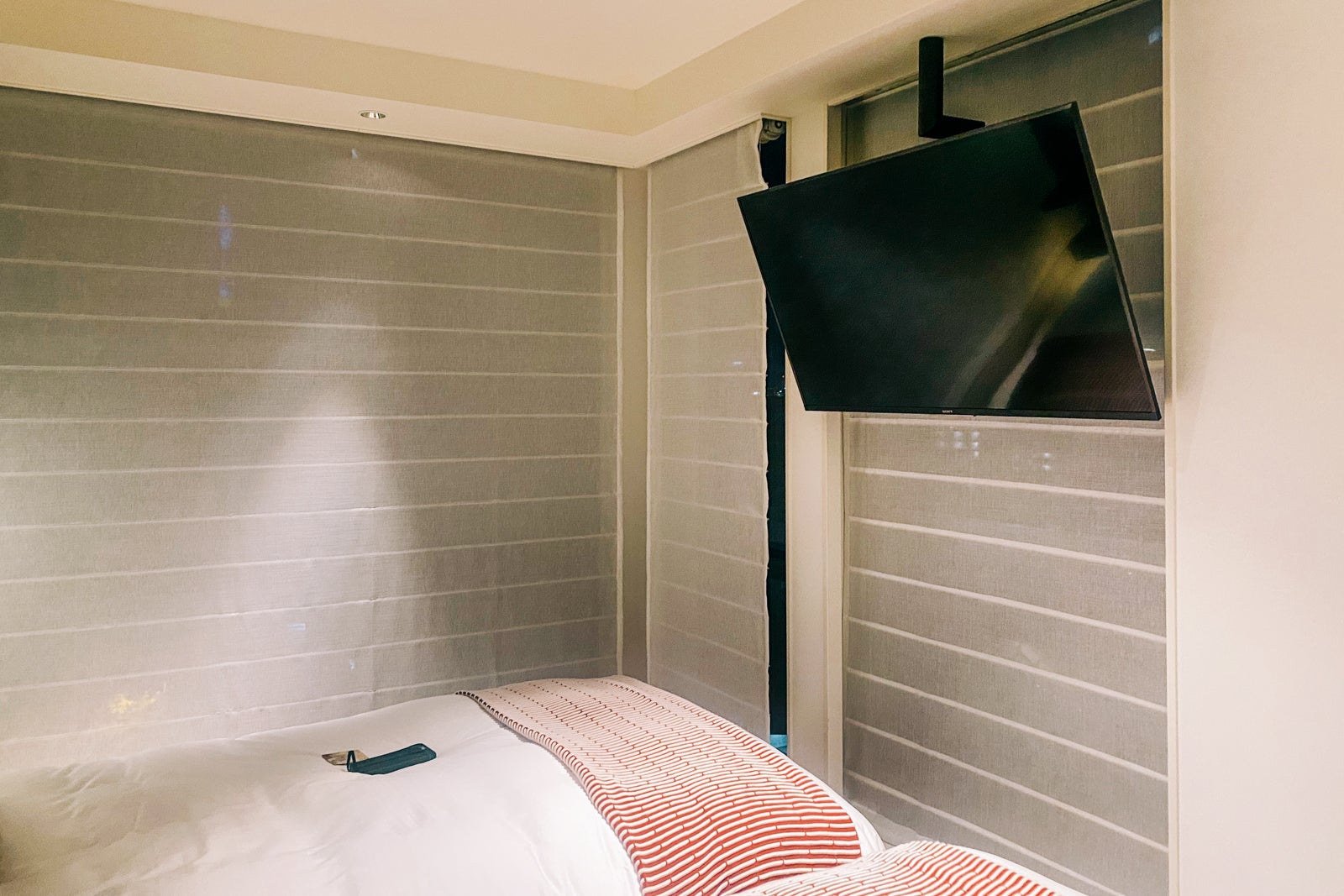
The hotel’s website (and measurements) really don’t get across how challenging many of the room configurations at this property can be.
Rooms vary considerably, even within the same category, so if you value space, you’ll definitely need to spend up for rooms in the premium ranks. The hotel’s public spaces and amenities are very much geared toward outgoing younger couples, so families may find its overall design ethos and vibe a challenge.
Choose your room carefully — many are compact and not for light sleepers
My first room at the Kimpton was not room 914 detailed above. It was 516, and it was so small that my immediate impression upon walking in was that there must be another door to a sitting area of sorts. Tokyo, just like New York, is known for its small hotel rooms, but this felt much, much smaller than the 28 square meters (301 square feet) advertised on Kimpton’s website.
The twin beds almost touched each wall and finding somewhere to store and unpack our carry-on bags felt like a jet-lagged game of Tetris. The bathroom was an impressive use of space, however, with a separate water closet, a deep-soaking granite-tiled tub and a vanity with shelves to one side that helped keep our things organized.
Since the social spaces at the Kimpton are warm and inviting, and most visitors to Tokyo generally sleep and change in their rooms, the Essential room isn’t a terrible option for solo travelers. Light sleepers, though, would have problems with the persistent traffic noise on the hotel’s low floors which overlook the adjacent thoroughfares.
After not sleeping much the first night, I stopped by reception and requested a quieter room. The staff was incredibly accommodating and since there were no quieter rooms available in the Essential category, they offered a complimentary upgrade to the King Premium room.
Your pooch will be in heaven, your kids not so much
Kimpton is perhaps the most pet-friendly hotel brand in the world. As was the case with many countries during the pandemic, Japan experienced a massive uptick in the number of pet-owning households, who were all keen to travel, eat and drink with their four-legged friends. Talk to any of the staff at this outpost and it’s clear pet lovers were a huge pandemic demographic, and that courtship is very much in evidence.
With no kid-friendly amenities like a pool, play-friendly outdoor spaces or kids’ menus, the Kimpton is geared more toward adults than families. Compact room designs with varying soundproofing and open-plan bathrooms in many rooms also don’t lend themselves well to families with young children. It is worth noting, however, that connecting rooms are offered and can be booked on the website.
Accessibility
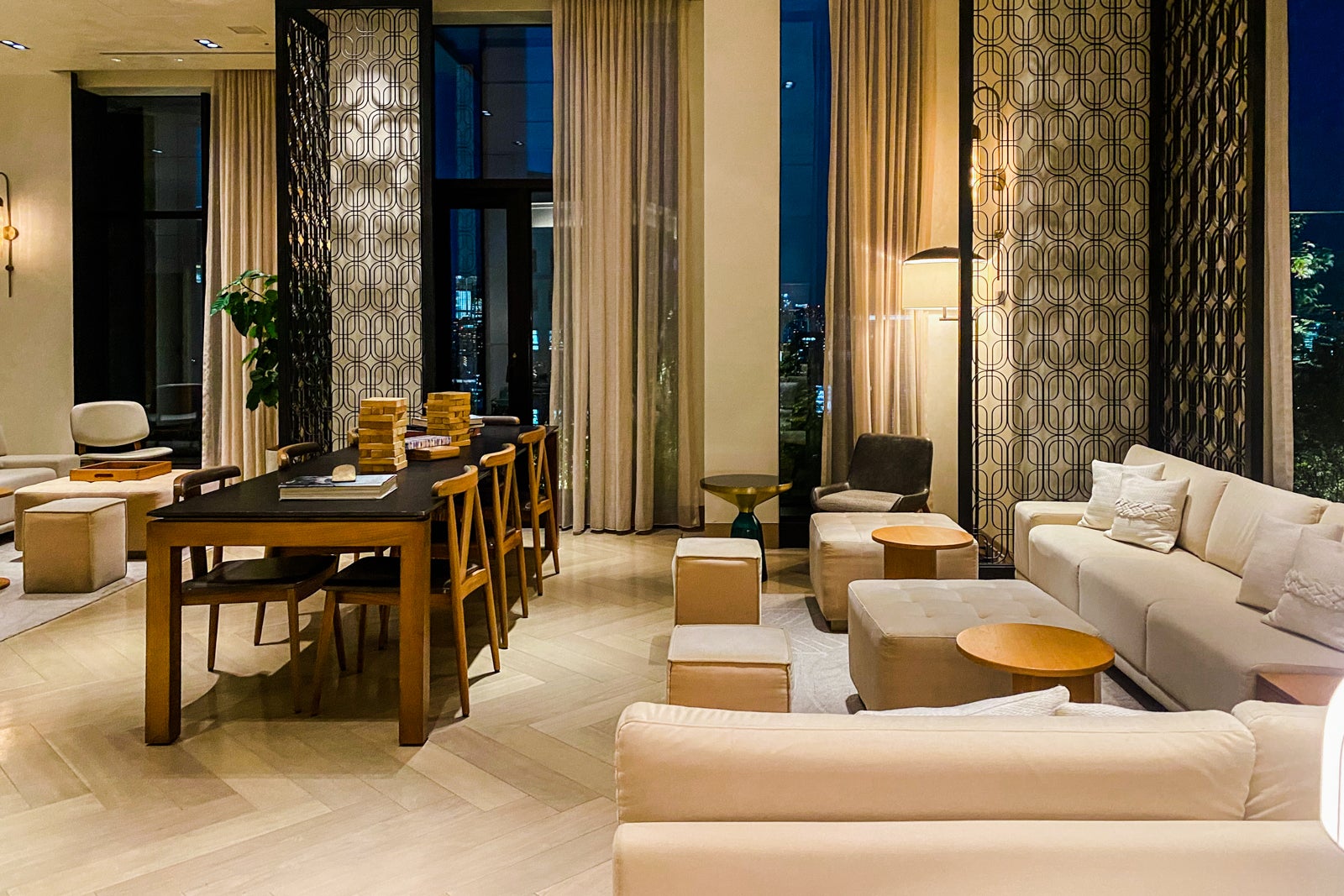
Despite its tight quarters and quirky dimensions, the hotel does accommodate travelers with accessibility needs. The main entrance, meeting space and restaurants are all accessible via ramps and there are audible and visual alerts in the elevators and hallways. The hotel offers valet parking, too.
There is one accessible room type that can be booked on the Kimpton website: the (type 2) Twin Studio Suite Additional Living Area (488 square feet), which features 32-inch doorways and grab rails in the roll-in shower and water closet.
Checking out
Kimpton fans will find all their favorite attributes and whimsical design elements at this Tokyo outpost. While the Manhattan-inspired design concept may not suit travelers looking to connect with the destination through a more immersive hotel experience, this shiny new Kimpton manages to feel more Japanese in spirit than many of its fellow U.S. hotel brands in the city thanks to striking contemporary Japanese artworks, amenities like yukata robes, the fashion-forward staff uniforms, delicious Japanese-inspired food and cocktails and accommodations that are streamlined but cheerful.
There are very few hotels in Tokyo in this midrange price category that combine a central location with chic spaces and destination restaurants that draw locals with their congenial ambiance and excellent cuisine — and even fewer where you can earn and burn IHG One Rewards to secure a free night or two.
Despite a couple of breakdowns in communication due to the language barrier, the staff was warm, efficient and extremely keen to resolve any problems and respond to individual needs. I wouldn’t hesitate to book a stay again…just not in the Essential room category.


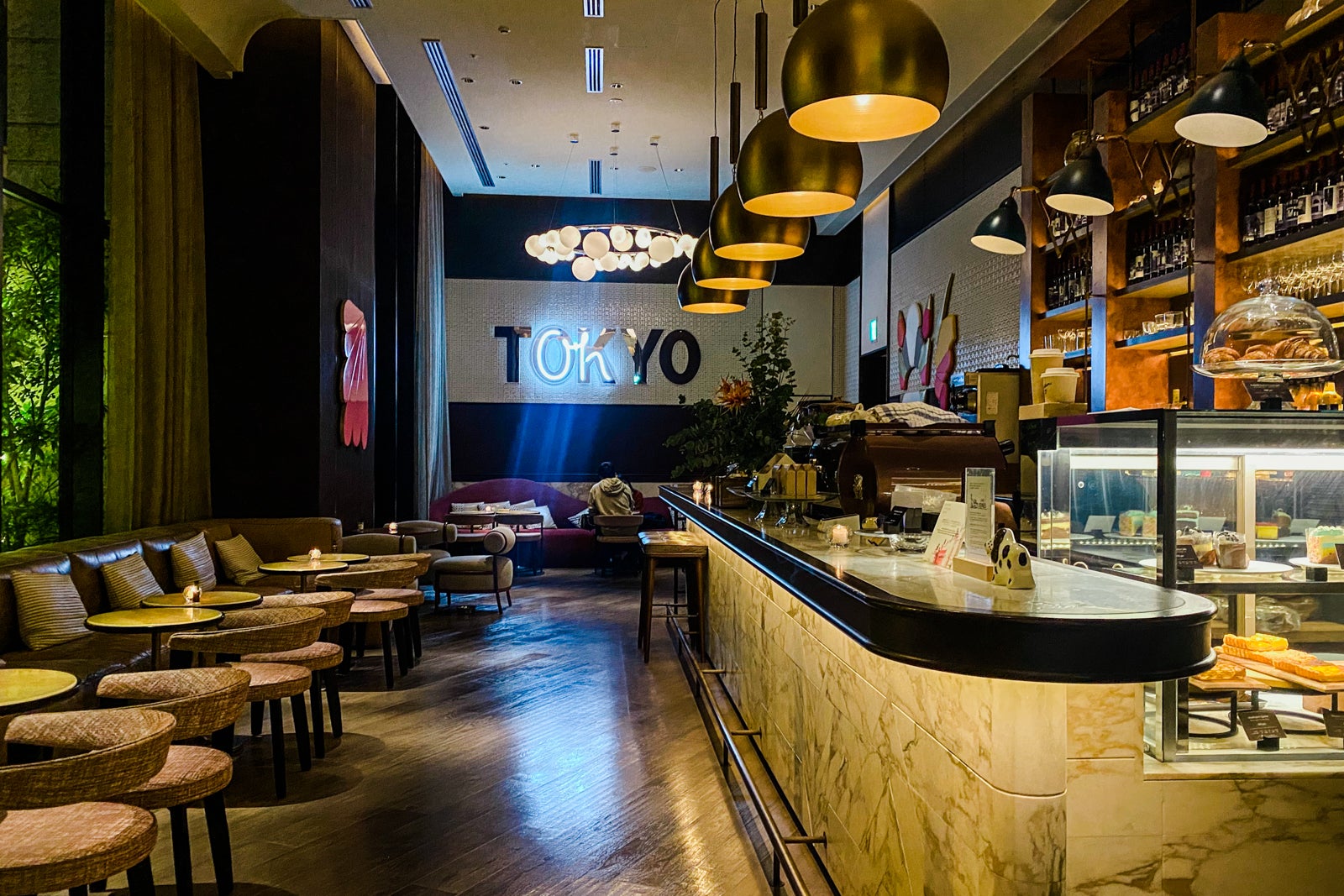
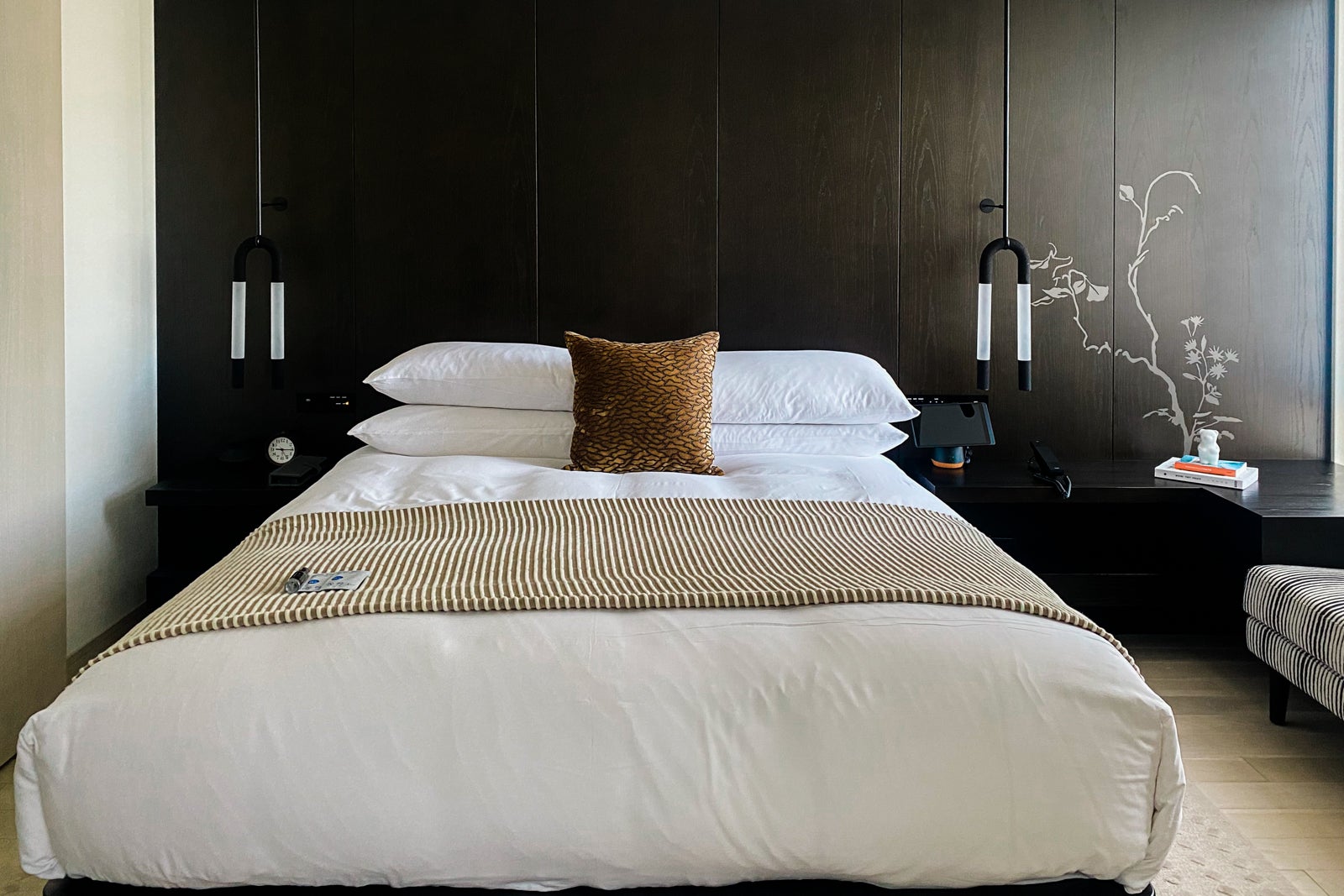
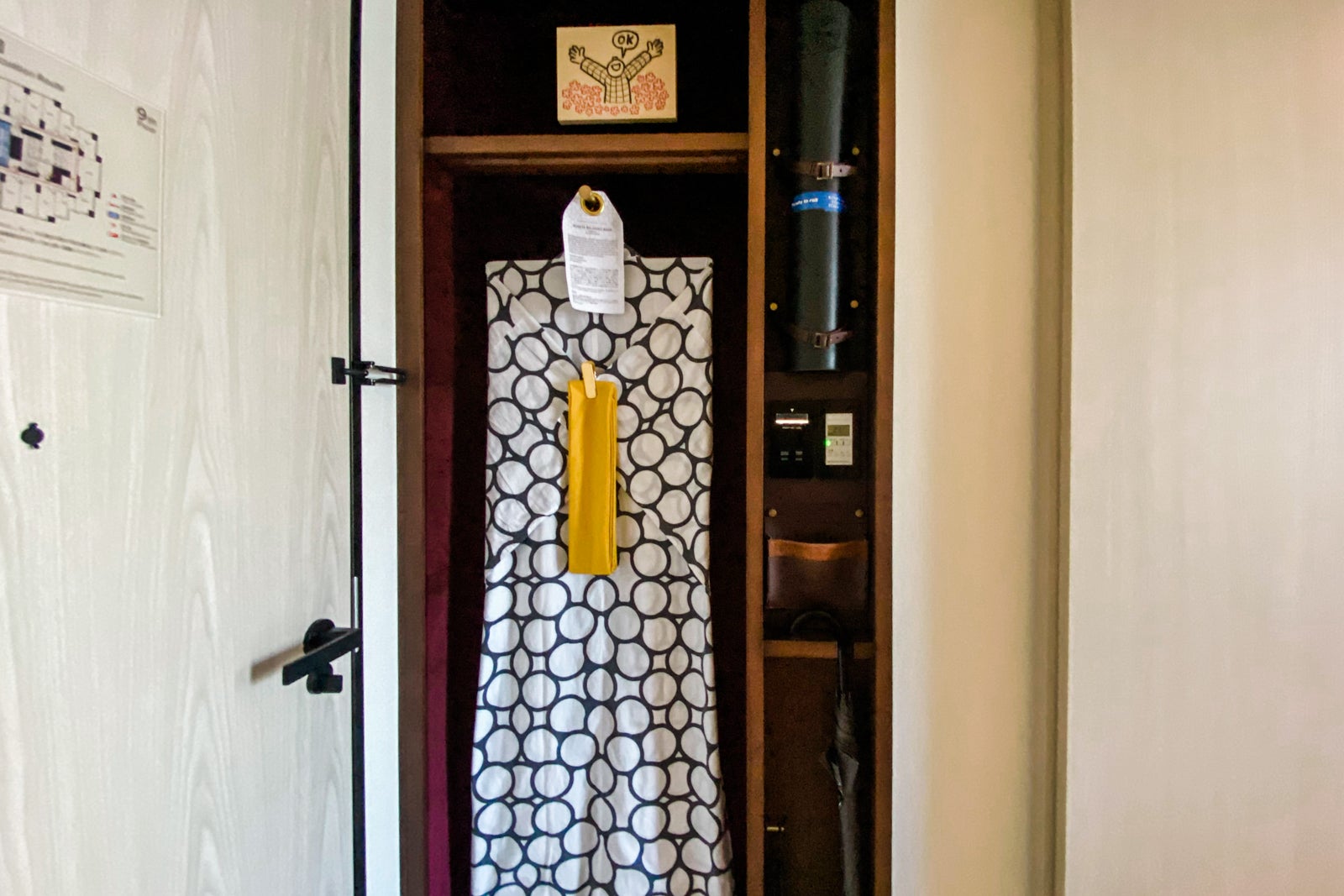
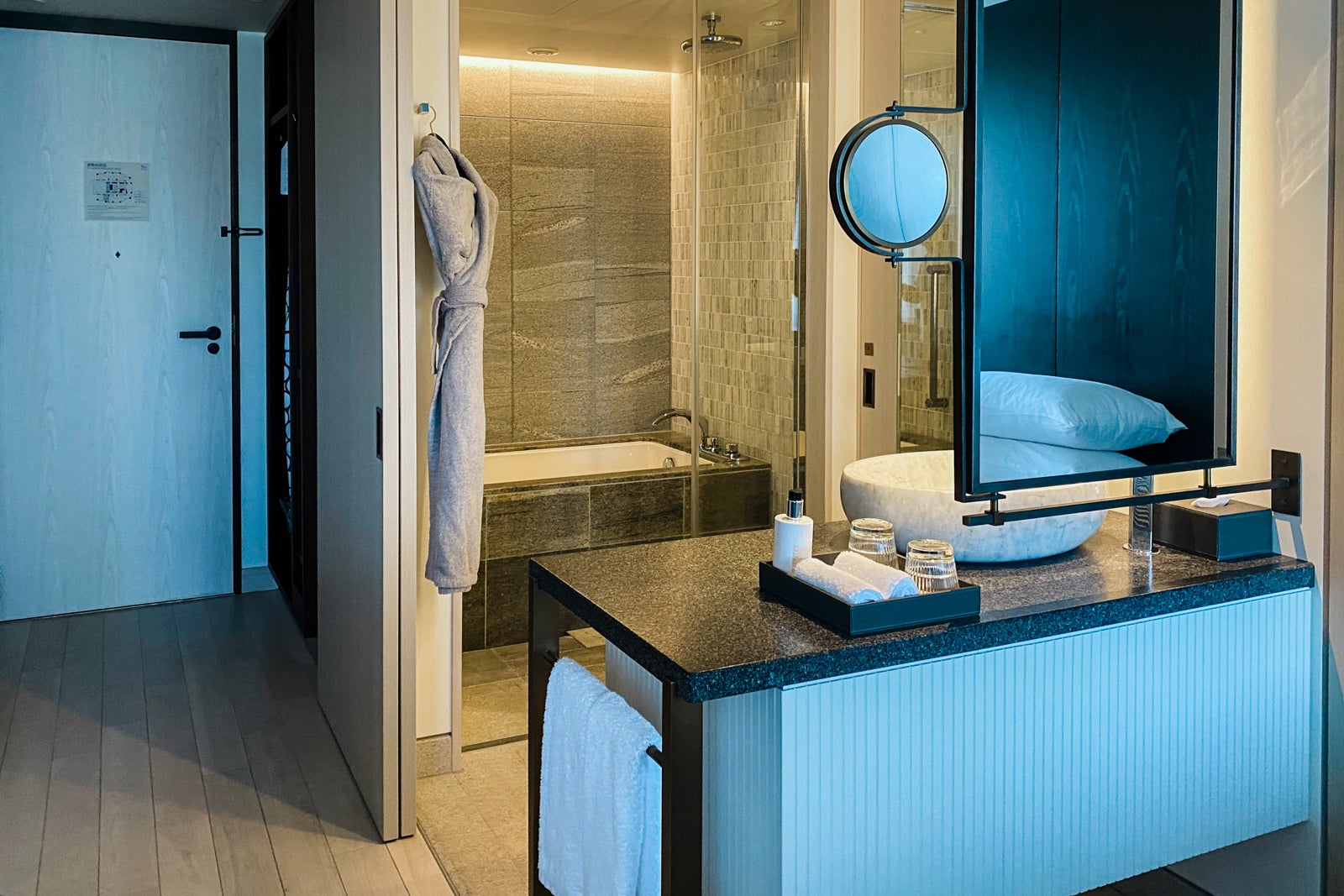
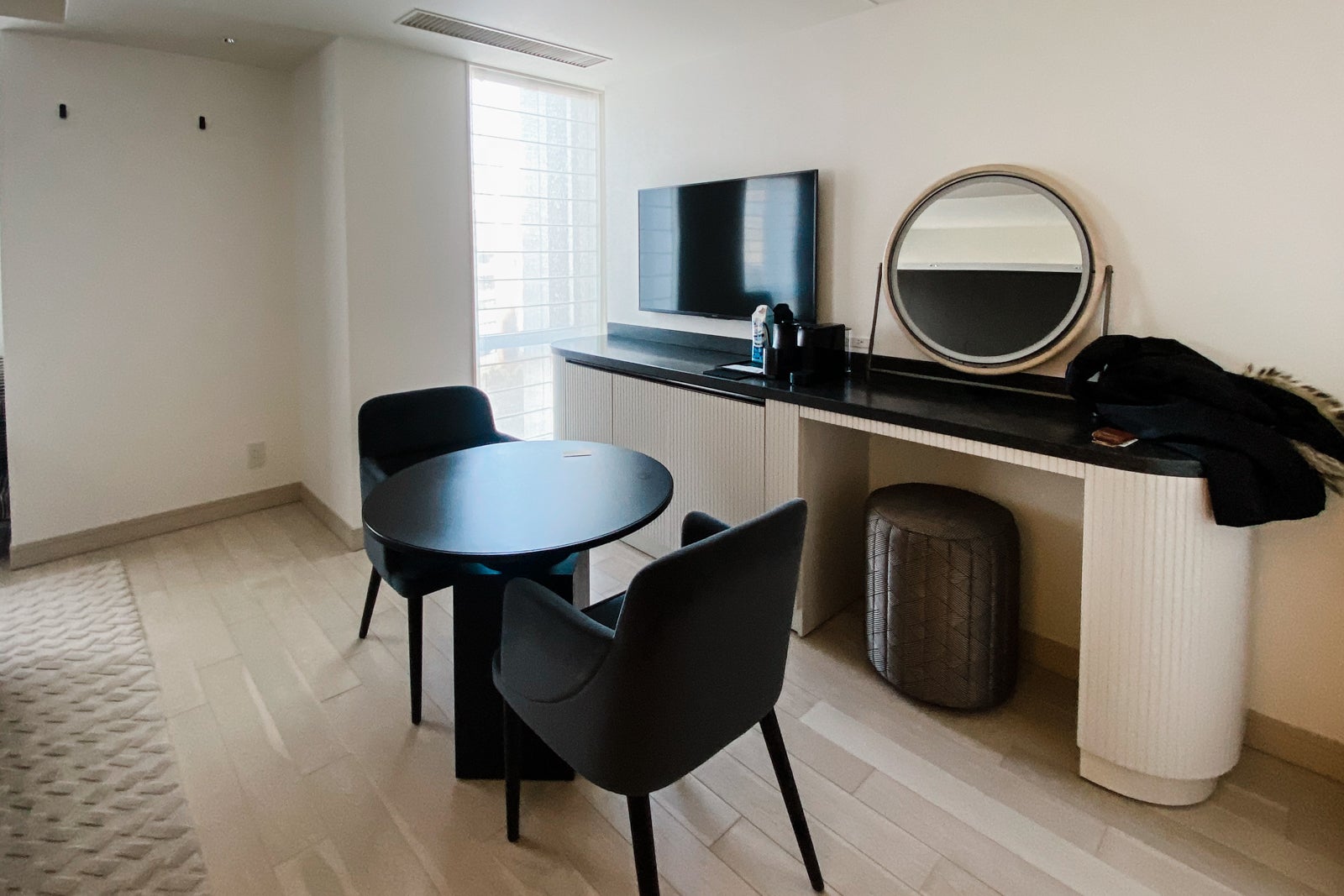
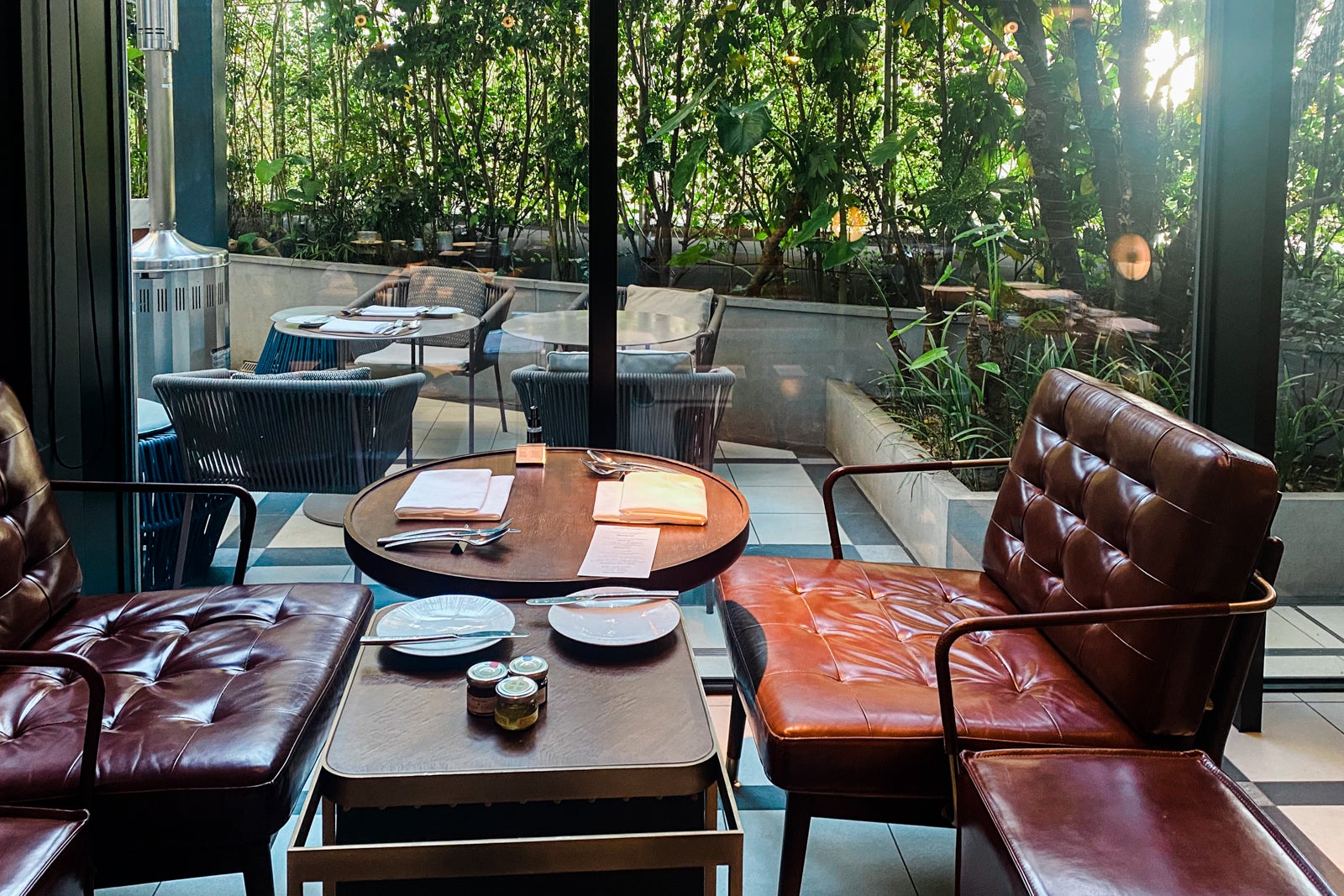
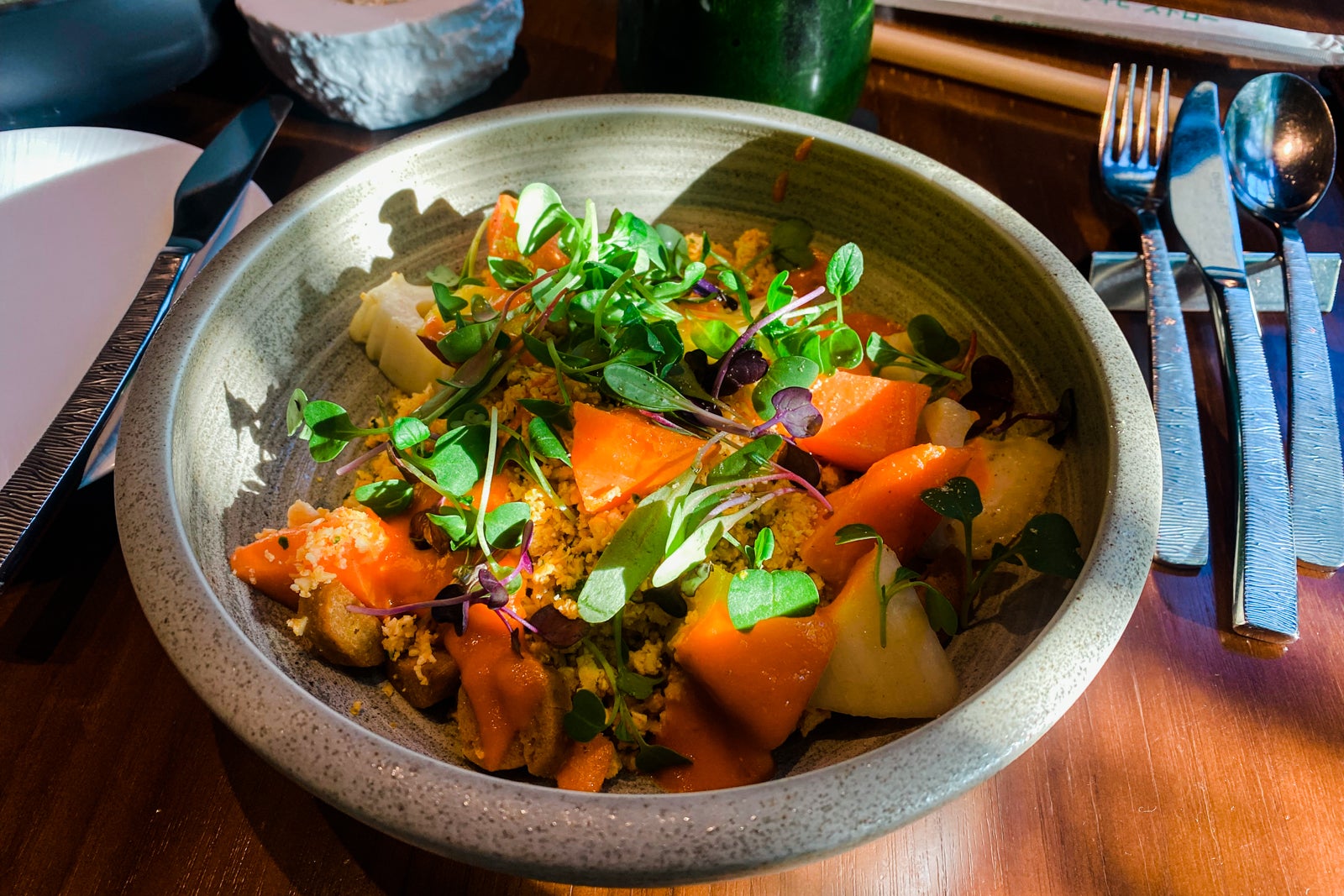
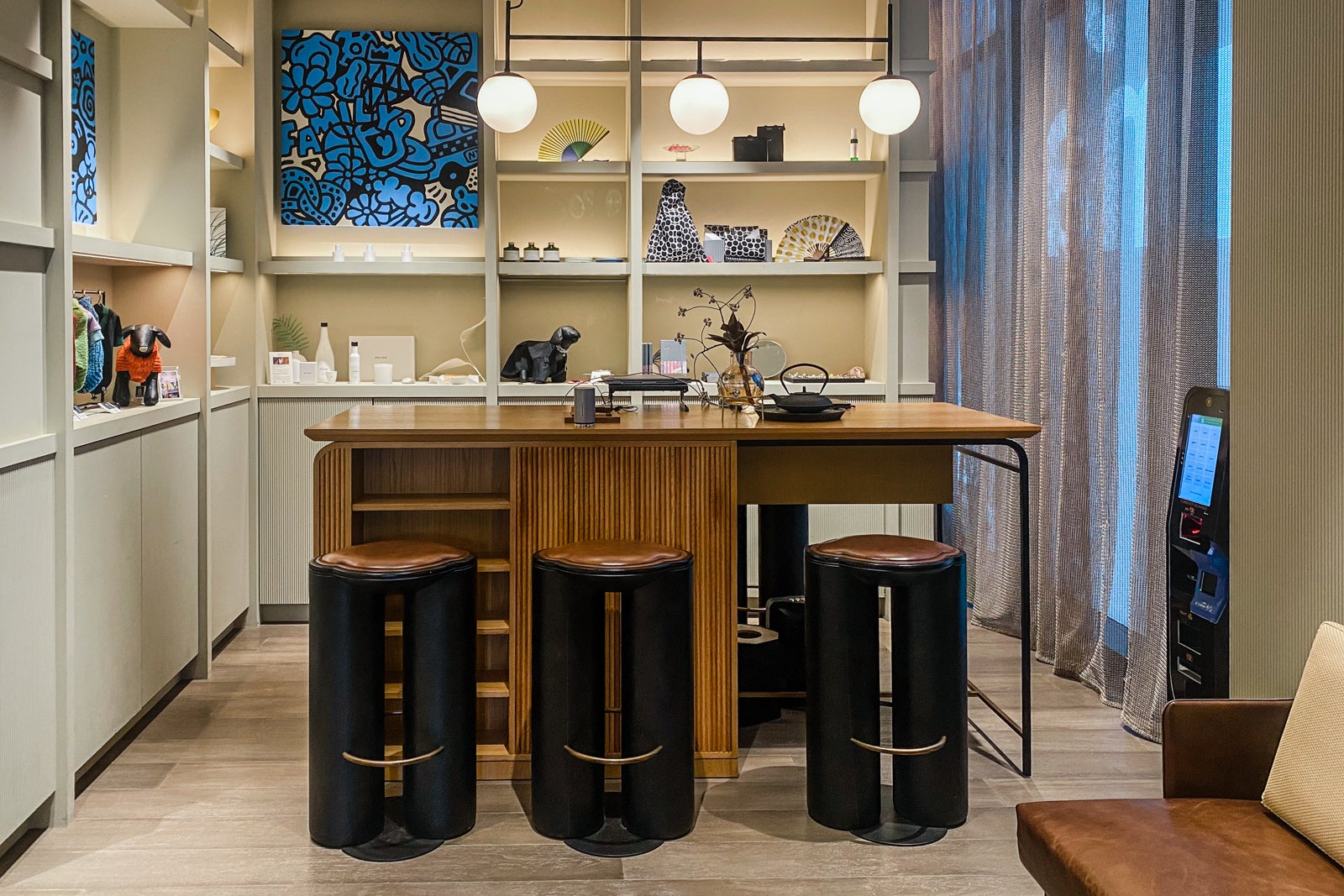
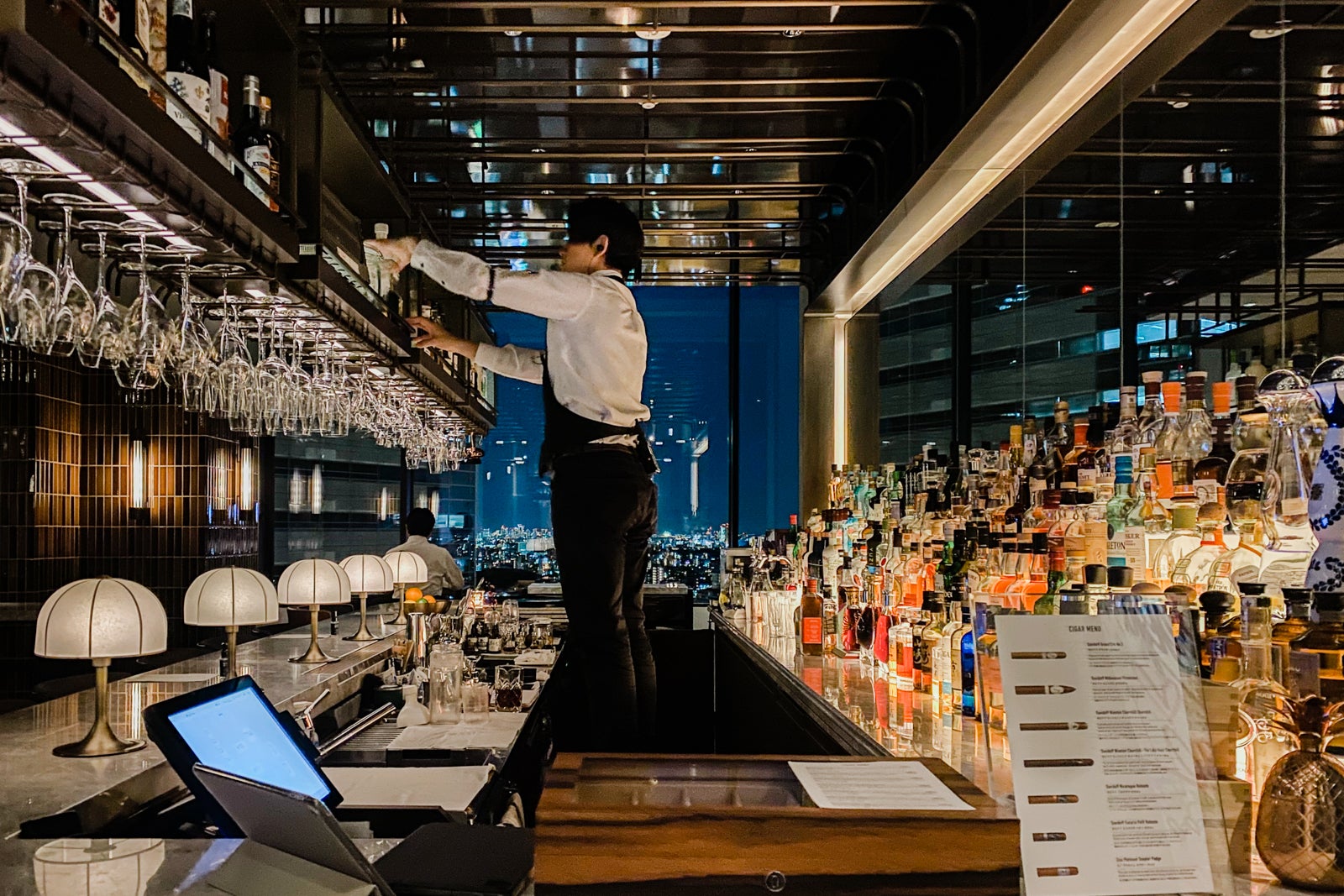
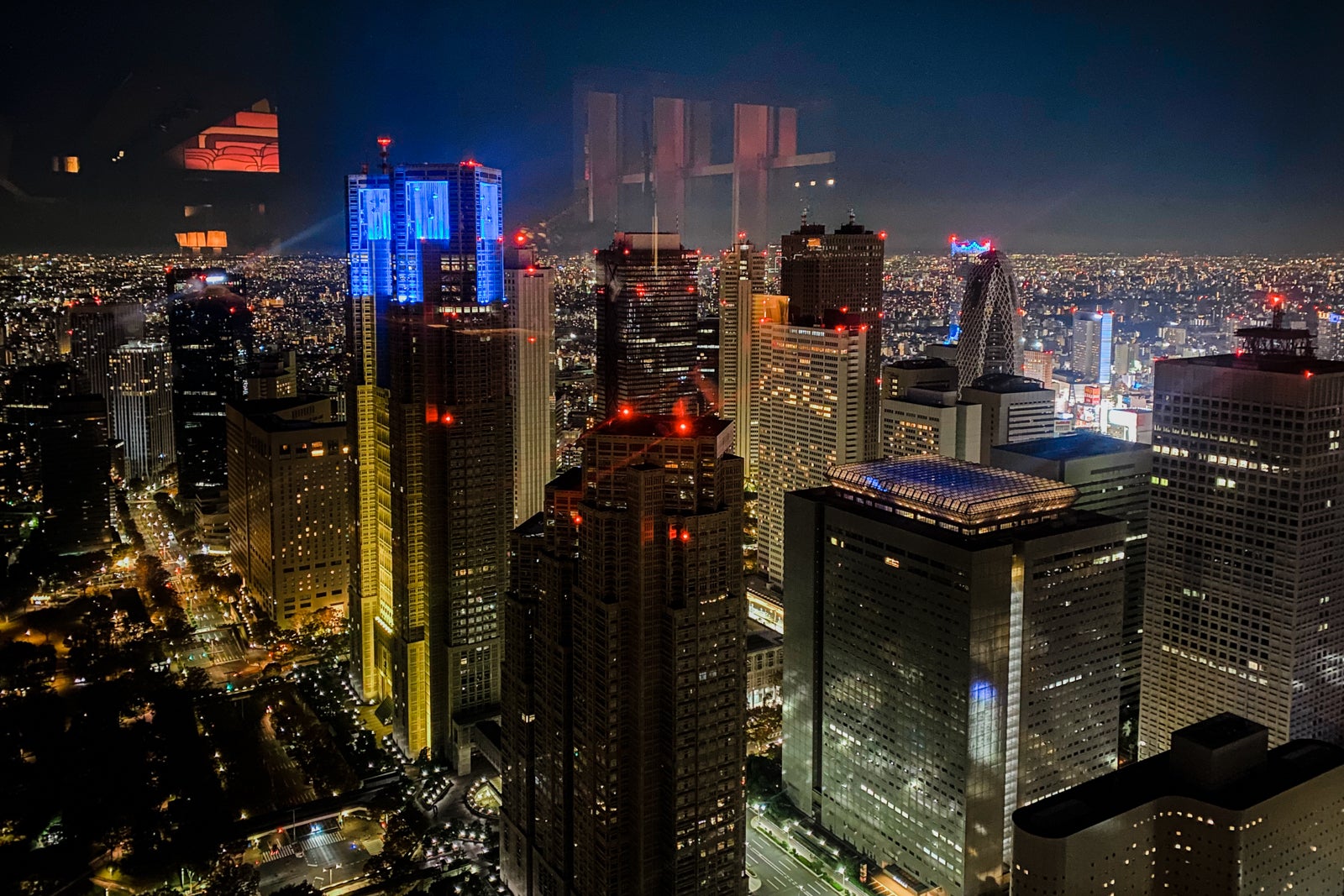
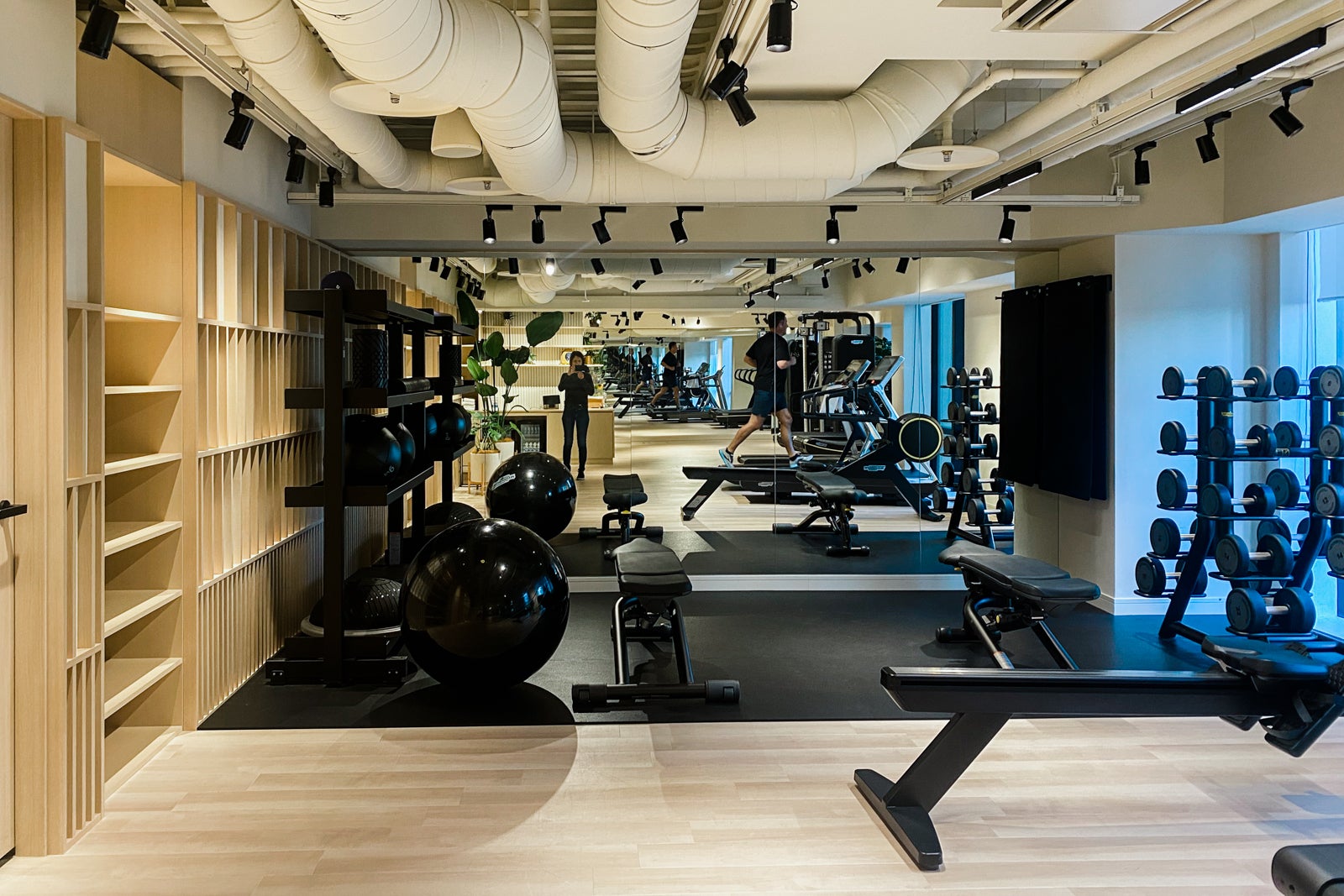
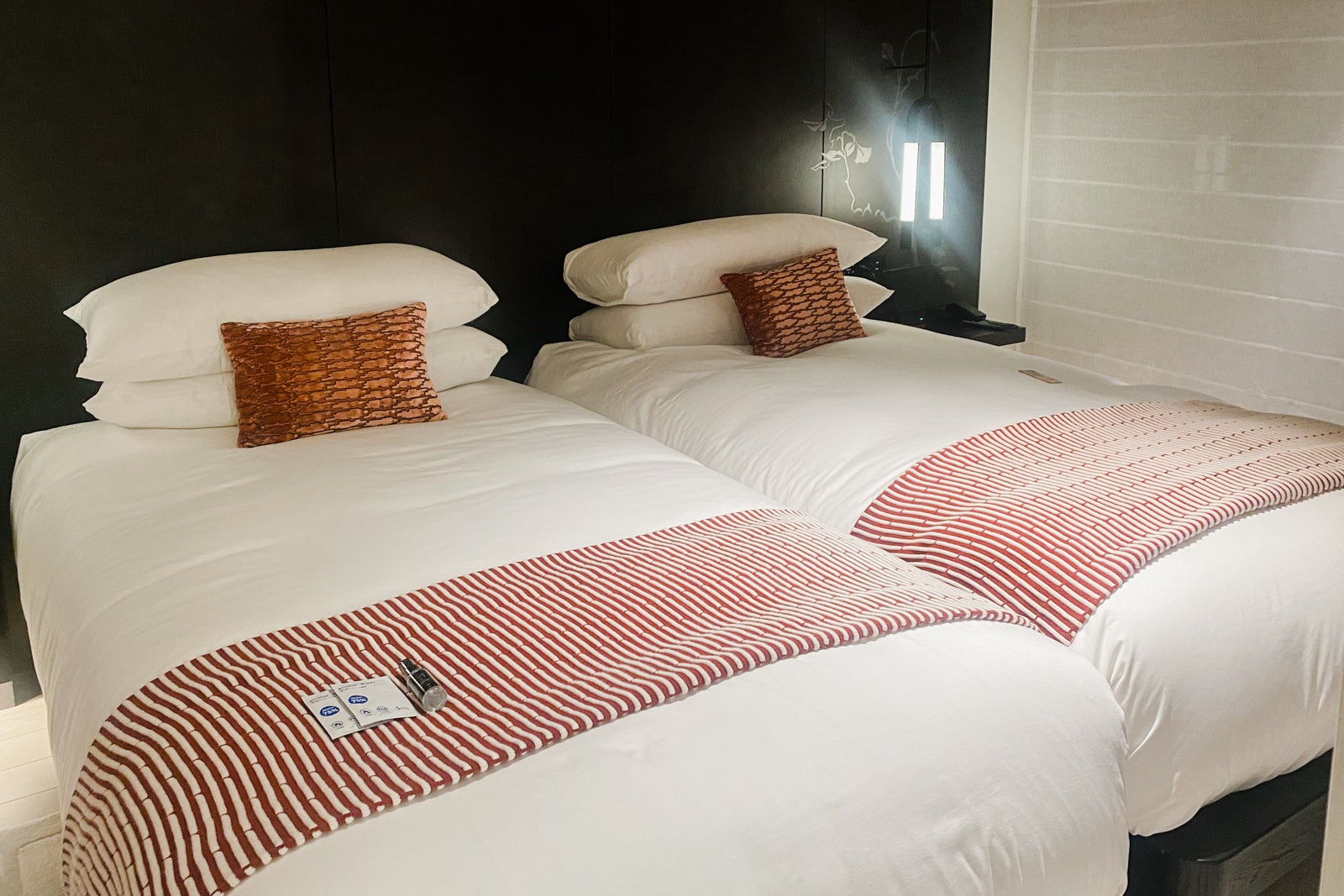
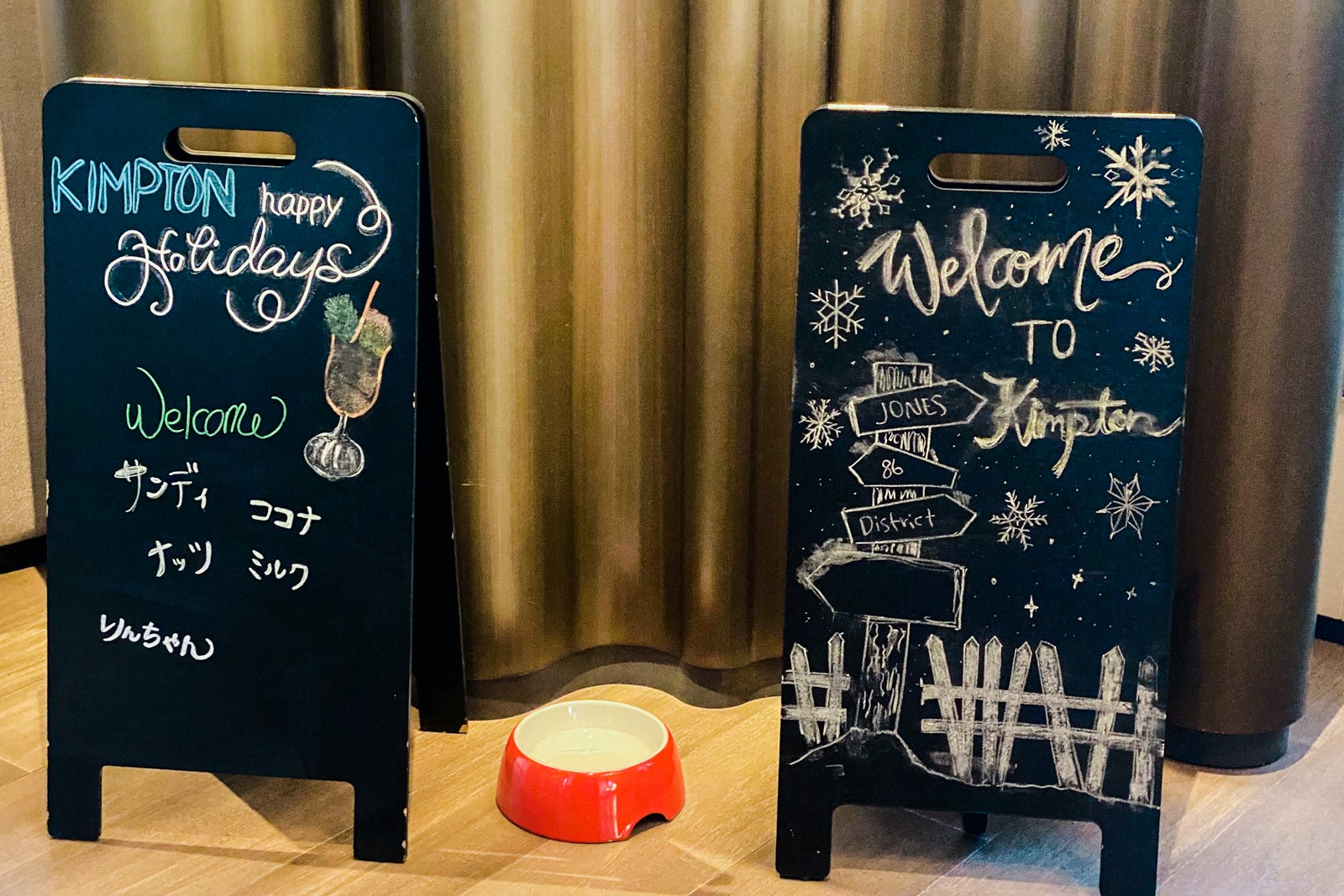










Leave a Reply